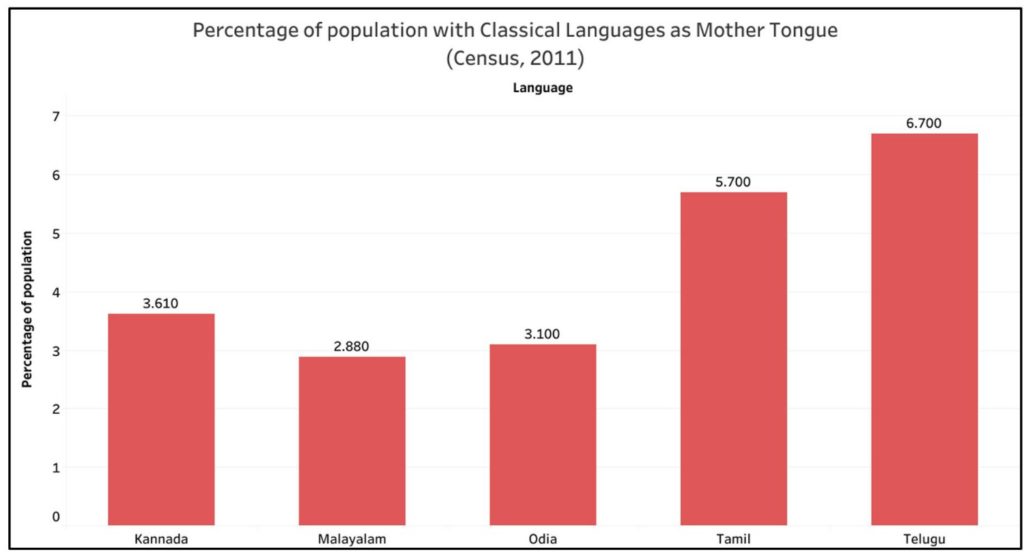[orc]The debate over languages ceases to stop. After Amit Shah’s statements on Hindi, the Prime Minister extolled the diversity of languages in India. But what is meant by Classical languages? How much such languages exist in India? Here is an explainer.
Discussion on Language has been at the center stage of India’s societal discourse over the last few weeks. While speaking at the ‘Howdy Modi’ event in Houston, Prime Minister Narendra Modi addressed the diaspora gathered at NRG stadium on Sunday saying that ‘everything is fine’ in eight different Indian languages- Punjabi, Gujarati, Telugu, Kannada, Tamil, Marathi, Bengali and Odia in addition to Hindi and English. He also stated that languages are an important identity of India’s liberal and democratic society. ‘Our languages are a great identity of our Liberal and Democratic Society. For centuries hundreds of languages, hundreds of dialects, have been moving forward in our country with a sense of co-existence and they still remain the mother tongue of millions of people. This diversity of India is the very basis of our Vibrant Democracy’ said the Prime Minister.
Recently, Home Minister Amit Shah’s statements on Hindi had triggered discussions across all sections of society including media & social media platforms.
What is the Status of various languages?
While Hindi and English are the official languages of the Central Government for communication and administrative purposes, no language in India has been conferred the status of the national language. As per Schedule VIII of the Constitution of India, 22 languages have been recognised as Scheduled languages. Also, till date, six languages have been conferred the status of ‘Classical Language’ in India. The first language to be accorded with that status is Tamil. Tamil was declared classical language back in 2004. In the following year, Sanskrit was accorded with the status. In 2008, Telugu and Kannada were conferred with the status followed by Malayalam in 2013. Odia is the latest addition to the list and received the status in 2014. The proposal of Maharashtra government to confer Marathi with the status is under consideration by the Central Government.
| Type | Languages |
|---|---|
| National Language of India | None |
| Official Languages of the Central Government | English & Hindi |
| Classical Languages | Tamil, Sanskrit, Kannada, Telugu, Malayalam & Odia |
4 of the 6 Classical languages are Dravidian
Of the six classical languages, five of them are regional languages except for Sanskrit which is not specific to any region. Tamil, Telugu, Kannada and Malayalam are Dravidian languages while Sanskrit and Odia are Indo-Aryan languages.
As per the 2011 Census, 78.1% of total population has one of the Indo-Aryan languages as mother tongue while 19.6% of the total population has one of the Dravidian languages as mother tongue. There are 21 and 17 languages under the family of Indo-Aryan and Dravidian languages respectively. It has to be noted that not all of these languages are recognized as scheduled languages in the constitution.
How many people speak these Classical languages?
As per 2011 census, the percentage of total population whose mother tongue is recorded as one of these classical languages is in the following chart. The number of people who reported Sanskrit as mother tongue is only 24,821. Since this number is small, the percentage of Sanskrit speakers with respect to the total population is negligible and hence, it has not been included in the graph.

The data also suggests that 93% of the people with mother tongue Kannada are in Karnataka. Similarly, 93% of those who recorded mother tongue as Malayalam are in Kerala. Tamil Nadu is home to 92.3% of the population whose mother tongue is Tamil and Odisha has 92.5% of the people who recorded Odia as mother tongue. In the case of Telugu, 87% of those who recorded it as their mother tongue are in Andhra Pradesh & Telangana. In the case of Sanskrit, 15.3% of those with Sanskrit as mother tongue are in Maharashtra. 12.3% and 13.6% of the people with mother tongue Sanskrit are in Uttar Pradesh and Bihar respectively. Population with Sanskrit as mother tongue are also found in Madhya Pradesh, West Bengal, Rajasthan, Karnataka, Goa and other states.
What is the criteria for conferring the status of Classical Language?
According to the Ministry of Culture, the norms for according status of classical language are that the language should have a recorded history of more than 1500 years with ancient valuable literature recorded in it. Further, the language has to be original and not derived from another speech community. The guidelines of the government are as follows:
- High antiquity of its early texts/recorded history over a period of 1500-2000 years
- A body of ancient literature/texts, which is considered a valuable heritage by generations of speakers
- The literary tradition to be original and not borrowed from another speech community
- The classical language and literature being distinct from modern, there may also be a discontinuity between the classical language and its later forms or its offshoots
Upon receiving the proposal for considering a language for the status, the Ministry of Culture refers it to the Committee on Linguistic Experts through the Sahithya Akademi for recommendations. The Ministry then forwards the proposal along with the recommendations to the Prime Minister’s Office for further action.
What are the benefits of being conferred the ‘Classical’ status?
The Ministry of Human Resources Development gives away two major international awards every year for scholars of eminence in Classical Indian Languages. Centre of Excellence for studies in Classical Languages is also set up. MHRD also sends a request to the University Grants Commission to create a certain number of Professional Chairs for the Classical Languages in central universities to begin with. Annually, funds are disbursed by the Central Government for promotion and development of these languages.
The Central Institute of Indian Languages located in Mysore, Karnataka works for the promotion of Kannada, Telugu, Malayalam and Odia. For the promotion of Tamil, a separate institute, Central Institute of Classical Tamil was established in Chennai, Tamil Nadu. Sanskrit language promotion is done by the Government through three deemed universities- Rashtriya Sanskrit Vidyapeeth (Tirupati), Rashtriya Sanskrit Sansthan and Shri Lal Bahadur Shastri Rashtriya Sanskrit Vidyapeeth in New Delhi.
Funds are allocated to the universities/institutes for seminars, book publications, projects, fellowships, scholarships, orientation programmes and workshops. As per the data provided in the answers in Lok Sabha, the allocation of funds appears to be meagre. The data also suggests that Sanskrit gets a lion’s share of these funds.
Presidential Awards in Classical Languages
As per the notification of MHRD on 01 March 2019 inviting recommendations for Presidential Award 2019, 21 awards for scholars of Sanskrit and 32 awards in the category of Classical languages have been called for, in addition to awards in other languages. The 32 awards in classical languages include 8 each in Classical Telugu, Classical Kannada, Classical Malayalam and Classical Odia. As Tamil was missing from the list, it led to a furore in Tamil Nadu. It was later clarified that the Central Institute of Classical Tamil (CICT) was giving awards for Tamil. However, the information for Tamil awards is available only till 2015-16 on the CICT website. Honouring Sanskrit scholars started in 1958 and from 2016, awards for the four classical languages were introduced.
Advocate in Chennai filed five writ petitions between 2008 and 2016 with respect to classical languages
R. Gandhi, an advocate in Chennai filed writ petitions in 2008 in the Madras High Court, one seeking reconstitution of the Committee of Linguistic Experts and the other challenging the notification of Telugu and Kannada as classical languages. In 2014, he filed another petition seeking strict adherence to the criteria laid down for classifying a language as classical and in 2015, he challenged the notification of Malayalam and Odia as classical languages. The Madras High Court in 2016 dismissed all these petitions and ordered that all the petitions related to this were closed. The Court also added that the petitioner could give his suggestions for determination of the type of literature, that can be the bench mark for qualification for consideration as a classical language. These writ petitions led to the delay in considering the proposal of Marathi.
The concept of classical languages has been a long debated issue since the notion has not been adopted by UNESCO. There have been debates around the criteria itself and whether or not each language satisfies all the conditions laid down. While the recognition in India is good first step towards promoting these languages, the meagre allocations do not do justice to the mandate.



1 Comment
Pingback: Explainer: What are Classical Languages of India? - Fact Checking Tools | Factbase.us